What Is NCAP And Its Variants?
Ever since we got our very own Bharat NCAP, every carmaker has been rightfully involved in a rat race to get their cars tested for a full-fat five-star rating. But how does this system work and how are crash tests done in other countries, lets find out!
By Sayan Paul
Published March 17, 2025

Table of Contents
- Global NCAP (Global)
- Euro NCAP (Europe)
- NHTSA (National Highway Traffic Safety Administration) - USA
- IIHS (Insurance Institute for Highway Safety) - USA
- KNCAP (Korean New Car Assessment Program) - South Korea
- Latin NCAP (Latin American New Car Assessment Program) - Latin America
1. Global NCAP (Global)
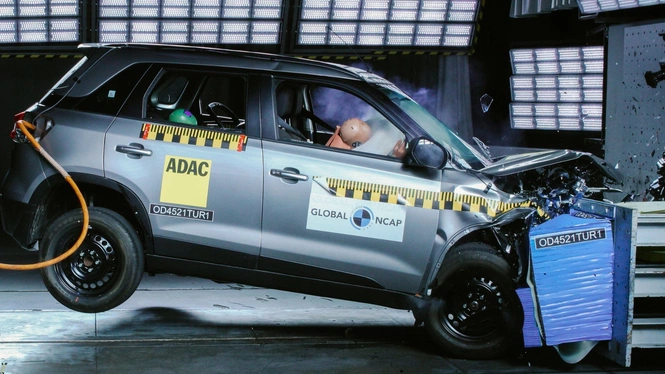
This is the big daddy of all NCAPS. Global NCAP is a global network aimed at improving road safety in emerging markets by promoting NCAP testing in countries where such programs are not yet available. It works with regional NCAPs like Euro NCAP, Latin NCAP, and others to implement global safety standards. Lately, it has conducted a 5-Star rated test of Skoda and Volkswagen offerings in India
- Frontal Crash Test: This simulates a head-on collision between the vehicle and a deformable barrier at 64 km/h. It measures the forces acting on the vehicle occupants, the integrity of the cabin, and the effectiveness of airbags and seatbelts.
- Side Impact Test: A moving barrier crashes into the side of the vehicle at 50 km/h, assessing the side protection for both front and rear occupants, including side airbags and the vehicle’s structural integrity.
- Pedestrian Protection Test: The vehicle’s ability to protect pedestrians during a collision is tested by evaluating the car's front end. This includes the bumper and the bonnet’s ability to absorb energy and prevent serious injuries.
- Whiplash Test: This test assesses the risk of neck injury for passengers in the event of a rear-end collision. It evaluates the effectiveness of the headrest and seat design in preventing whiplash injuries.
- Safety Assist Features: This includes the evaluation of active safety features such as Autonomous Emergency Braking (AEB), Lane Assist, Electronic Stability Control (ESC), and Blind Spot Detection. These features are tested for their ability to prevent accidents or reduce injury severity.
2. Euro NCAP (Europe)
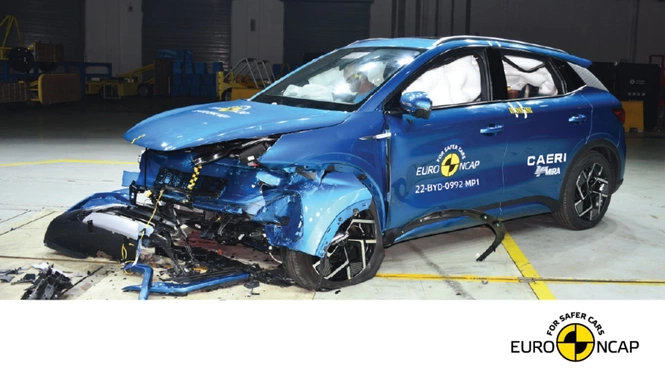
Euro NCAP is one of the most respected and thorough safety assessment programs in the world. It tests new vehicles sold in Europe and provides safety ratings based on various crash tests and advanced safety technology assessments.
- Frontal Impact (Crash Test): The vehicle collides with a fixed deformable barrier at 64 km/h. This test evaluates how well the vehicle absorbs the impact, the risk of injury to the driver and passenger, and the effectiveness of the airbags and seat belts.
- Side Impact Test: A moving barrier strikes the vehicle at 50 km/h, simulating a side collision. It assesses the protection of both the driver and the passenger in the front and rear seats.
- Pole Side Impact Test: The car is impacted at 29 km/h by a rigid pole, simulating a side collision with a narrow object, like a tree or lamppost. This test is crucial for understanding how well the vehicle protects against chest and head injuries.
- Pedestrian Protection: This test evaluates how the vehicle’s design and structure minimize injury to pedestrians in a collision. It measures the impact to the head, legs, and pelvis in different pedestrian crash scenarios.
- Whiplash Test: Euro NCAP assesses the effectiveness of the vehicle's headrests and seats in preventing neck injuries during rear-end collisions. The test measures the forces acting on the head and neck of the occupants.
- Safety Assist Features: Euro NCAP evaluates advanced driver assistance systems (ADAS) such as:
- Autonomous Emergency Braking (AEB): Tests how well the vehicle detects potential collisions and automatically applies the brakes to avoid or mitigate an accident.
- Lane Support Systems: Tests if the car can detect lane markings and assist the driver in staying within the lane.
- Blind Spot Detection: Assesses the effectiveness of systems that alert drivers to vehicles in their blind spots.
- Child Occupant Protection: Euro NCAP also evaluates how well a vehicle can protect children in various seating positions, using child safety seats and systems.
3. NHTSA (National Highway Traffic Safety Administration) - USA
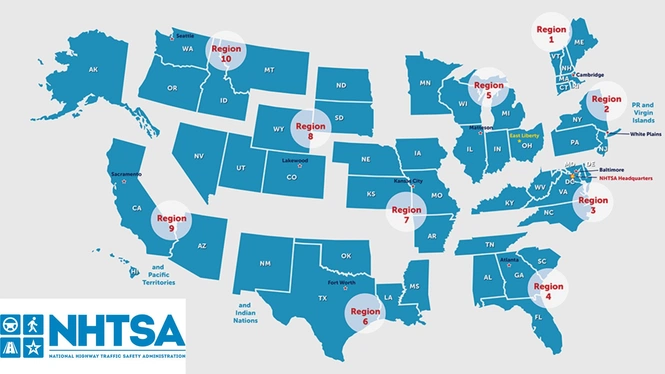
NHTSA is a U.S. government agency that plays a crucial role in vehicle safety. It provides the public with safety ratings for vehicles sold in the United States, including information on crash tests, rollover risk, and overall safety features. It has one of the hardest crash-test regimens with up to 50+ parameter
- Frontal Crash Test: The car is driven into a fixed barrier at 35 mph (56 km/h), with crash dummies inside to evaluate injury risk. The test measures the deformation of the vehicle, the forces acting on the occupants, and the effectiveness of the seatbelts and airbags.
- Side Impact Test: A moving barrier hits the vehicle’s side at 38.5 mph (62 km/h), simulating a side-impact crash. This test focuses on the protection of the chest, abdomen, and head in side collisions.
- Rollover Resistance Test: This test involves tipping the vehicle at an angle to simulate the forces acting during sharp turns or quick maneuvers. It measures the likelihood of the vehicle rolling over, a significant contributor to severe injuries in accidents.
- Side Pole Impact Test : The vehicle is struck by a rigid pole at 20 mph (32 km/h) to simulate a collision with a narrow object like a tree or telephone pole. This test focuses on side head and chest protection.
- Crashworthiness & Safety Features: NHTSA assesses the performance of airbags, seatbelts, and headrests in preventing injury. It also evaluates the presence of safety technologies like Anti-lock Braking Systems (ABS) and Electronic Stability Control (ESC).
4. IIHS (Insurance Institute for Highway Safety) - USA
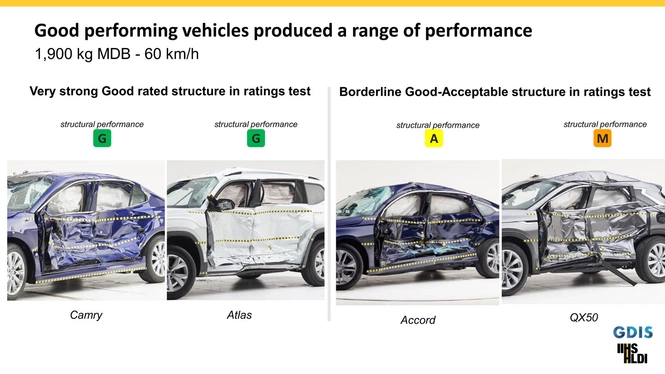
IIHS is an independent, non-profit organization that performs crash testing and safety assessments for vehicles sold in the U.S. IIHS is known for its tough testing protocols, particularly for front crash scenarios, and its "Top Safety Pick" awards. A major difference between NHTSA and IIHS is that the former is a government wing while the latter is independent
- Small Overlap Front Crash Test: The car collides with 25% of its front end at 40 mph (64 km/h) with a deformable barrier. This test is designed to simulate accidents where a car strikes a narrow object, such as a tree or pole, on one side.
- Moderate Overlap Front Test: A more traditional frontal crash test where 40% of the car’s front end collides with a fixed barrier at 40 mph (64 km/h). This test assesses occupant safety and the vehicle’s structural integrity.
- Side Impact Test: The car is struck by a moving barrier at 31 mph (50 km/h) to simulate a side collision. IIHS also conducts a side pole crash test to evaluate how well the car protects against side impacts with narrow objects.
- Roof Strength Test: The car’s roof is subjected to a force equivalent to the weight of the vehicle to assess the risk of injury in a rollover accident.
- Seat and Head Restraint Tests: These tests measure the effectiveness of the seat and headrest in preventing whiplash during rear-end collisions.
- Front Crash Prevention: IIHS evaluates active safety features like AEB (Autonomous Emergency Braking) to determine how well these systems can prevent crashes or mitigate their severity.
5. KNCAP (Korean New Car Assessment Program) - South Korea
KNCAP is South Korea's national vehicle safety program, designed to provide safety ratings for vehicles sold within the country. This program is operated by the Korean Automobile Testing & Research Institute (KATRI) and aims to raise consumer awareness of vehicle safety features. KNCAP uses a variety of tests to evaluate a car's crashworthiness, child protection, pedestrian protection, and active safety technologies.
- Frontal Crash Test: A vehicle crashes head-on into a deformable barrier at 56 km/h (35 mph) to evaluate the protection of the driver and passenger during a collision.
- Side Impact Test: A moving deformable barrier strikes the vehicle’s side at 50 km/h (31 mph) to assess the side impact protection for both the driver and passenger.
- Pedestrian Protection Test: This test evaluates how well the vehicle's design minimizes injury to pedestrians in the event of a collision. This includes examining the car's bumper, hood, and A-pillars.
- Whiplash Test: KNCAP tests the effectiveness of headrests and seat designs in preventing neck injuries from rear-end collisions.
- Active Safety Features: Evaluate technologies such as Autonomous Emergency Braking (AEB), Lane Departure Warning (LDW), Blind Spot Detection (BSD), and Electronic Stability Control (ESC).
6. Latin NCAP (Latin American New Car Assessment Program) - Latin America

Latin NCAP evaluates vehicles sold in Latin America and provides important information on how well cars perform in various safety tests. The program aims to improve car safety standards in the region, where road traffic fatalities are a significant concern. Latin NCAP is an independent initiative, supported by consumer protection organizations, automakers, and government bodies across Latin America.
- Frontal Impact Test: A crash test where the vehicle impacts a deformable barrier at 64 km/h (40 mph) to assess frontal protection for the driver and passenger.
- Side Impact Test: A moving deformable barrier strikes the vehicle’s side at 50 km/h (31 mph), testing the protection of the occupants during a side collision.
- Pedestrian Protection Test: Evaluates the risk of injury to pedestrians in a collision, assessing the vehicle's front design and components like the bumper, hood, and A-pillars.
- Child Occupant Protection: Latin NCAP checks how well child seats are protected in the vehicle, testing both the installation and the effectiveness of child safety features.
- Safety Assist Features: Evaluation of advanced safety technologies, including Autonomous Emergency Braking (AEB), Lane Departure Warning (LDW), Speed Assistance Systems, and Electronic Stability Control (ESC).
7. Bharat NCAP (Bharatiya New Car Assessment Program) - India
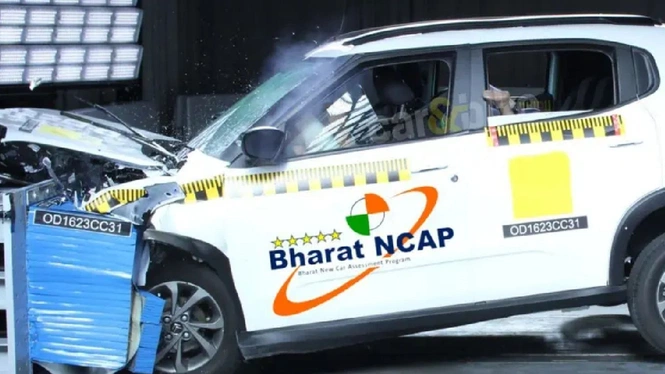
“The new safety regime under BHARAT NCAP and AIS-197 is a mutual win-win for manufacturers and consumers” – Nitin Gadkari
The newborn Bharat NCAP is India's own vehicle safety assessment program, designed to encourage the use of better vehicle safety standards and technologies within the Indian automotive market. The program was introduced by the Ministry of Road Transport and Highways (MoRTH) in India and aims to provide safety ratings for cars sold in India, similar to international NCAP programs like Euro NCAP.
Do note that their crash test speed is among the lowest in the group due to India’s 120 kmph speed limit. Cars like Nexon, Altroz and Punch have fared well in BNCAP
- Frontal Crash Test: The vehicle is subjected to a frontal collision with a deformable barrier at 56 km/h (35 mph), simulating head-on crashes. The test evaluates the protection of occupants and the effectiveness of restraint systems.
- Side Impact Test: A moving barrier impacts the vehicle’s side at 50 km/h (31 mph), assessing the side protection for front and rear seat passengers.
- Pedestrian Protection: This test measures how well the vehicle minimizes injuries to pedestrians in the event of a collision.
- Safety Assist Features: Bharat NCAP evaluates technologies such as Autonomous Emergency Braking (AEB), Lane Assist, Electronic Stability Control (ESC), and Driver Attention Monitoring.
8. CNCAP (China New Car Assessment Program) - China
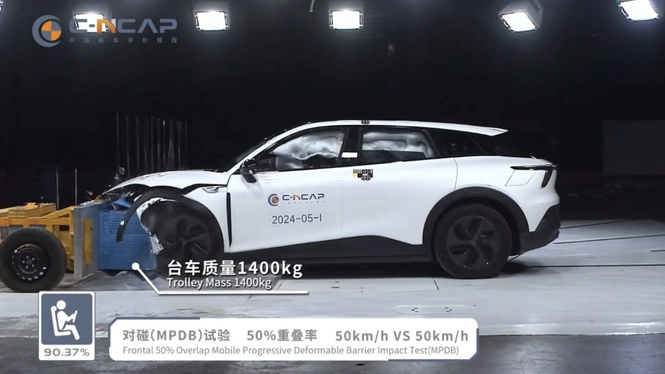
CNCAP is China’s national vehicle safety assessment program, which evaluates vehicles sold in the Chinese market. Launched in 2006, CNCAP is managed by the China Automotive Technology and Research Center (CATARC). It also tests for niche stuff like the vulnerable road user (VRU) protection section that includes a Head-shaped test, Leg-shaped test, AEB-VRU test
- Frontal Crash Test: The car crashes into a deformable barrier at 56 km/h (35 mph), assessing the structural integrity of the vehicle and occupant protection during a head-on collision.
- Side Impact Test: A moving deformable barrier strikes the vehicle’s side at 50 km/h (31 mph) to evaluate the protection of occupants from side impacts.
- Pole Side Impact Test: The vehicle is hit by a rigid pole at 29 km/h (18 mph) to simulate the effect of a collision with a narrow object like a tree or lamppost.
- Pedestrian Protection: This evaluates the risk of injury to pedestrians during a collision. It includes the assessment of the vehicle's front-end design, including the hood, bumper, and A-pillars.
- Whiplash Protection: CNCAP also assesses the potential for neck injuries during rear-end collisions by evaluating the seat design and headrests.
- Advanced Driver Assistance Systems (ADAS): This includes systems such as Autonomous Emergency Braking (AEB), Lane Keeping Assist, Blind Spot Monitoring, and Traffic Sign Recognition.
9. ANCAP- Australian New Car Assessment Program
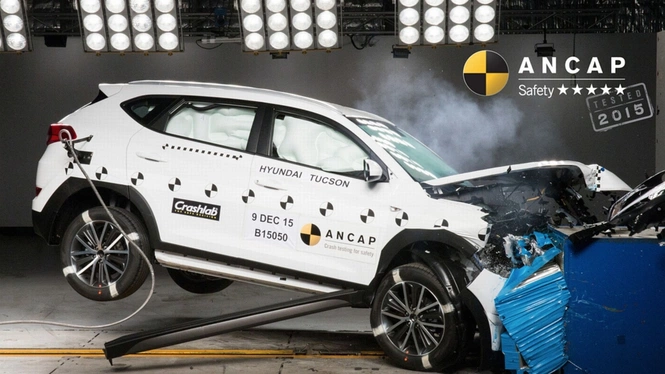
The Australian New Car Assessment Program (ANCAP) and InPara (the International Program for Automotive Safety Ratings) focus on evaluating vehicle safety. ANCAP was established in 1992 and assesses vehicle performance in various crash tests, safety features, and driver-assist technologies. InPara works similarly by focusing on global safety standards to ensure cars are safe for consumers.
Both programs aim to reduce road fatalities and injuries through stringent evaluations.
- Frontal Offset Crash Test: Simulates a collision at 64 km/h into a deformable barrier. Measures injury risk to driver and passenger.
- Full-Width Crash Test: Tests protection for both front occupants in a head-on collision at 50 km/h.
- Side Impact Crash Test: Evaluates how well a vehicle protects occupants in side collisions, including side pole impacts at 29 km/h.
- Pedestrian Protection: Assesses the vehicle’s front-end design to minimize injuries to pedestrians.
- Whiplash Protection: Tests head restraints and seatback design to prevent neck injuries in rear-end crashes.
- Child Occupant Protection: Assesses the safety of child restraint systems during frontal, side, and rear impacts.
- Crash Avoidance Systems: Evaluate features such as automatic emergency braking (AEB), lane-keeping assist, and electronic stability control (ESC) for their ability to prevent accidents.
- Safety Assist: Rates features like airbags, seatbelt reminders, and advanced driver assistance systems.
- Rollover Resistance: Assesses the risk of a vehicle rolling over in an accident based on its design and stability.
Write a comment
Comments
No comments yet. Be the first to comment!



![Navi Mumbai Gears Up for Maharashtra’s First FIA Grade Street Race[Postponed]](https://cdn.carhp.in/news/7a8e2e35-1a51-46fd-aade-5755b1216e28.png?format=webp&width=400&q=75)




![Top 10 Features The Upcoming Mahindra XEV 9S Will Have [updated]](https://cdn.carhp.in/news/fc71b37b-3118-4327-9372-ca626c0f4f11.png?format=webp&width=400&q=75)
